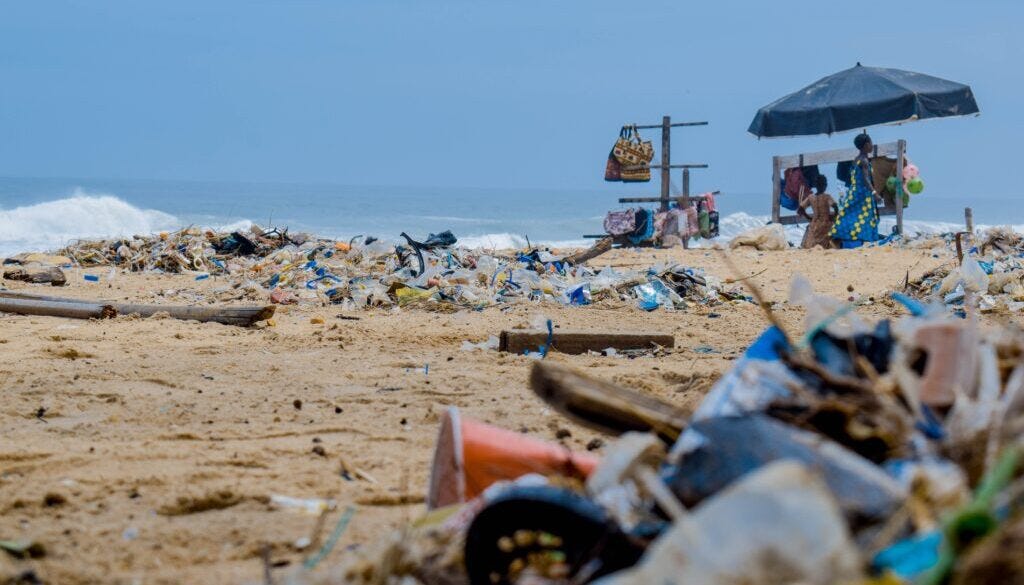Must-read recap: The New Lede's top stories
Companies eye settlements on eve of PFAS trial; Syngenta's "SWAT" team; PFAS in sewage sludge on NY farmland; UN plastics treaty; groups seek moratoriums on CO2 pipelines; CA banning diesel trucks.
On eve of bellwether PFAS trial, chemical giants DuPont, 3M eye billion-dollar settlements
Just days before the start of a bellwether trial in South Carolina over PFAS contamination of drinking water, DuPont and two related companies said they would pay close to $1.2 billion to settle liability claims brought by public water systems serving the vast majority of the US population.
PFAS maker 3M was reportedly also considering a settlement that would keep the company from having to face allegations that it was responsible for knowingly contaminating drinking water supplies around the United States.
The trial set to start Monday is expected to spotlight long-held secret documents about the chemical giant 3M’s knowledge about the dangers of its per- and polyfluoroalkyl substances (PFAS) and how it worked with DuPont to conceal risks of PFAS from the public.
DuPont and its related companies were recently severed from the case as they negotiated the settlement in which DuPont will pay roughly $400 million; Chemours, a DuPont spinoff, will pay $592 million; and another DuPont-related company, Corteva, will pay about $193 million.
The companies said the settlement excludes personal injury claims due to alleged exposure to PFAS, as well as claims by state Attorneys General about PFAS contamination of natural resources.
Bloomberg reported Friday that 3M was negotiating a $10 billion payout that would resolve claims and avoid Monday’s trial.
Regarding the potential settlement, 3M said in an email to The New Lede “we don’t comment on rumors or speculation.” In a court filing 3M said that it was not liable and that it “never owned, operated, or otherwise controlled the facilities, disposal sites, and other purported sources of PFAS or related compounds.” The company lacked the “necessary controls over its products after the point of sale,” it said in the filing. (Read the rest of the story.)
Syngenta’s “SWAT” team - Internal files reveal secret strategies to influence science
Global chemical giant Syngenta has sought to secretly influence scientific research regarding links between its top-selling weed killer and Parkinson’s, internal corporate documents show.
While numerous independent researchers have determined that the weed killer, paraquat, can cause neurological changes that are hallmarks of Parkinson’s, Syngenta has always maintained that the evidence linking paraquat to Parkinson’s disease is “fragmentary” and “inconclusive.”
But the scientific record they point to as proof of paraquat’s safety is one that Syngenta officials, scientists and lawyers in the US and the UK have worked over decades to create, and at times, covertly manipulate, according to a trove of internal Syngenta files reviewed by the The New Lede in a collaboration with The Guardian.
The files reveal an array of tactics, including enlisting a prominent UK scientist and other outside researchers who authored scientific literature that did not disclose any involvement with Syngenta; misleading regulators about the existence of unfavorable research conducted by its own scientists; and engaging lawyers to review and suggest edits for scientific reports in ways that downplayed worrisome findings.
The files also show that Syngenta created what officials called a “PQ SWAT team” to be ready to respond to new independent scientific reports that could interfere with Syngenta’s “freedom to sell” paraquat. The group, also referred to as Paraquat Communications Management Team,” was to convene “immediately on notification” of the publication of a new study, “triage the situation,” and plan a response, including commissioning a “scientific critique.”
A key goal was to “create an international scientific consensus against the hypothesis that paraquat is a risk factor for Parkinson’s disease,” the documents state.
In another example of a company tactic, an outside lawyer hired by Syngenta to work with its scientists was asked to review and suggest edits on internal meeting minutes regarding paraquat safety. The lawyer pushed scientists to alter “problematic language” and scientific conclusions deemed “unhelpful” to the corporate defense of paraquat. (Read the rest of the story.)
New York fails to protect farmland from PFAS in sewage sludge, report finds
Highlighting a practice that compromises farmland nationwide, a new report finds that sewage sludge spread as fertilizer on New York state fields contains toxic chemicals that sicken farmers, contaminate crops, and threaten consumer health.
The report, published Thursday by the Sierra Club Atlantic Chapter, suggests that the state’s Department of Environmental Conservation (DEC) has failed to prevent dangerous per- and polyfluoroalkyl substances (PFAS) from entering the environment through the practice, and urges the state to put a stop to the contamination.
“What we are talking about here is the active permitting… of PFAS-contaminated sewer sludge being spread over farmland to create food that we then consume,” New York state assembly member Anna Kelles said in a press briefing. “It’s literally creating a mechanism to get PFAS to bioaccumulate in human tissue.”
Kelles is working with Senator Rachel May to pass a bill that would require wastewater treatment plants to test effluent for PFAS contamination.
PFAS chemicals are associated with serious health conditions including cancers, thyroid disease, liver damage, and harm to pregnant women and babies. These so-called “forever chemicals” take hundreds of years to break down in the environment and are harmful even in tiny concentrations.
“We’re taking an enormous risk when we spread sludge on farmland,” said Adam Nordell, an organic farmer in Maine. Nordell was forced to learn about the risk firsthand the winter before last, when he and his wife discovered PFAS in their well water at levels 400 times higher than Maine’s interim drinking water standard.
“Our farm had been managed organically for seven years under our management and previously under organic practices for 25 years,” Nordell said in the briefing. “But a prior generation in the early 1990s spread the land with sludge from two wastewater districts for a total of four years.” (Read the rest of the story.
Amid global debate, UN plastics treaty at risk of falling short
A United Nations (UN) effort to put an end to global plastic pollution is badly needed, but is also at high risk of falling short of its goals amid debate over myriad complex issues, according to environmental advocates.
A paper published Thursday by Chatham House, an independent policy institute, and the Global Water Partnership (GWP), a coalition of thousands of water research and advocacy organizations around the world, warned that a global plastics treaty will face many hurdles, including required coordination and legislation among national governments.
“Many of the current efforts by national and local governments, industry, and civil society are still highly uncoordinated and often focus on downstream solutions,” the authors of the paper wrote. “They fail to address the source of plastic leakage.”
The UN committee on plastics was meeting in Paris this week to develop an international treaty that could include legally binding measures to be implemented in countries around the world. The UN Environment Programme (UNEP), which is hosting the talks, has outlined a goal of reducing plastic waste by 80% by 2040.
The meeting is the second of five set to take place as the UN committee draft a treaty it hopes all countries will agree to by the end of 2024.
“Without dramatic reductions in plastic production and eliminating toxic chemicals from plastics, we risk a significant global ecological disruption,” Charles Margulis, a spokesperson for the International Pollutants Elimination Network, said in a statement.
Plastic pollution is a growing issue worldwide. In 2019, 22 million tons of plastic escaped into the environment—a number expected to double by 2060 if no action is taken. Plastic pollution allows hazardous chemicals, such as phthalates and vinyl chloride, to leach into the environment, sometimes finding their way into drinking water and posing risks to human health in the form of cancers, reproductive issues, and developmental problems. (Read the rest of the story.)
Citing safety concerns, groups seek moratorium on new CO2 pipelines
Environmental and public health advocates are calling on President Joe Biden to issue a moratorium on new carbon dioxide pipelines, citing “serious safety concerns” and significant gaps in current federal safety regulations.
The effort comes as the Pipeline and Hazardous Materials Safety Administration (PHMSA) holds a public meeting in Iowa to gather stakeholder input as it prepares to update its safety regulations governing CO2 transport by pipeline.
“A moratorium on dangerous and underregulated carbon dioxide pipelines is essential to protect communities and the environment,” Maggie Coulter, an attorney at the Center for Biological Diversity’s Climate Law Institute, said in a statement.
In a letter to President Biden released on Tuesday, more than 150 organizations urged the president to issue an executive order halting federal permits for CO2 pipelines while insisting that states hold off on granting state permits for these pipelines until PHMSA completes its updated regulations.
Last year PHMSA announced it would be initiating a new rulemaking on CO2 pipeline safety in response to a pipeline rupture in Satartia, Mississippi in February 2020 that released a large plume of highly pressurized CO2, sending nearly 50 people to the hospital and causing around 300 people to be evacuated. The letter to President Biden references the disaster, warning “our communities face the risk of much larger and more devastating ruptures” in the absence of updated federal regulations.
The president’s negotiated deal with congressional Republicans to raise the debt ceiling could also weaken federal environmental reviews and reduce public input on energy-related infrastructure and other development projects including CO2 pipelines, environmental advocacy groups say.
Iowa is at the epicenter of the issue, as the site of proposals to build three new carbon dioxide pipelines that would stretch across the upper Midwest. The pipelines would transport CO2 captured from ethanol and fertilizer plants to underground injection sites in North Dakota and Illinois. (Read the rest of the story.)
Postcard from California: “No one is safe” — state banning diesel trucks
Forty percent of all US imports of consumer goods come through the adjacent ports of Los Angeles and Long Beach. Most of the merchandise is initially trucked to one of thousands of distribution center warehouses in the Inland Empire of San Bernardino and Riverside counties, where it is sorted and packaged for delivery to American homes and stores.
Every day, an estimated 40,000 diesel trucks travel inland from the ports via the Interstate 710 freeway, spewing tons of dirty soot linked to lung cancer, heart attacks, asthma and other respiratory illnesses, and premature birth. The toxic toll of diesel truck emissions is why public health researchers and smog-choked residents call the I-710 corridor “the diesel death zone.”
Communities in the I-710 corridor are overwhelmingly made up of Black, Latino and lower-income populations, as are the neighborhoods around the port of Oakland, the ninth-busiest in the country, where thousands of diesels a day carry imports to an ever-growing number of warehouses in the northern San Joaquin Valley.
Port communities suffer disproportionately for America’s addiction to cheap imports. But diesel pollution “plagues every corner of the country,“ according to the nonprofit Clean Air Task Force. Nationwide, almost 70% of all freight is carried by more than 11 million diesel trucks.
Unlikely as it may seem to anyone ever stuck behind a smoke-belching big rig, for decades diesel was actually hyped as a cleaner fuel than gasoline. But 25 years ago, California state scientists identified diesel exhaust as a toxic air contaminant, based on its potential to cause cancer. After numerous other studies confirmed and strengthened the finding, in 2012 the International Agency for Research on Cancer, an arm of the World Health Organization, classified diesel exhaust as carcinogenic to humans.
Now, in a decision with far-reaching impacts for public health and shipping, last month California became the first jurisdiction in the world to order a phase-out of diesel trucks.
The California Air Resources Board (CARB) voted unanimously to require that beginning in 2036, all medium- and heavy-duty trucks sold in the state must be electric or powered by other zero-emission technologies. Large trucking companies must convert their California fleets to all-electric by 2042. Most crucially, relief is coming sooner to port communities: As of 2035, no diesel trucks will be permitted to enter or exit California ports. (Read the rest of the story.)









Syngenta sounds like Monsanto all over again. When will use our voices to make a difference. Get in touch with AARP - since Parkinson's impact older people. We march for everything. Let's start marching.
You will need only 100 people to start a march. What does 100 people do....they bring the media and the media love them or hate them will bring attention to our causes.
Carey has provided us with a variety of details on the impact to our water supply to toxic chemicals and its link to cancers. Parkinson's Disease. It hits all of us